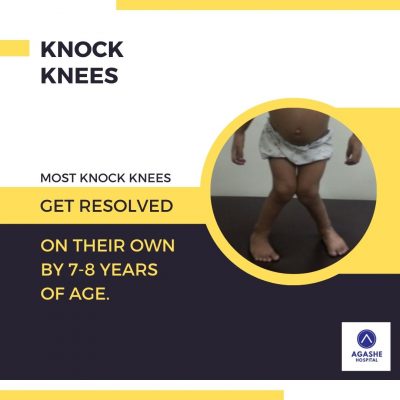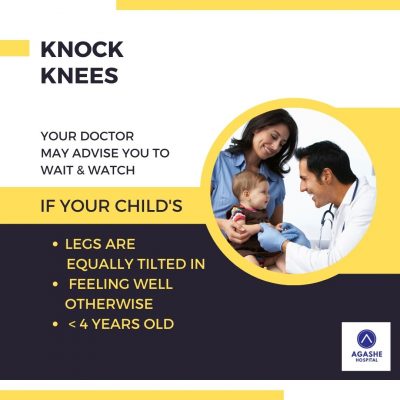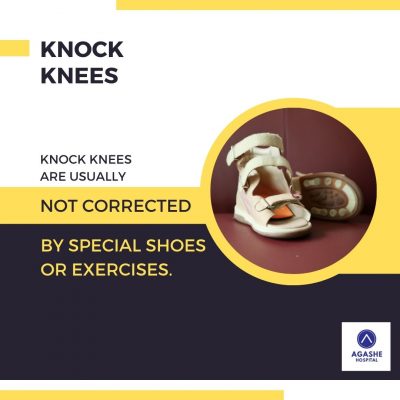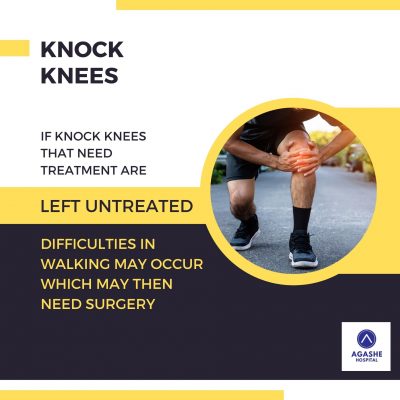Knock Knees
What is knock knee?
Knock knees are a condition where the legs turn inwards such that the knees touch each other but the ankles remain apart, often as much as 8 centimeters apart. This is also called as Genu Valgum.
What are the causes of knock knees?
The most common cause is normal development of bone as the child grows. Due to their position when they are in their mother’s wombs, babies often start out being bow legged. Once they begin to walk, their legs begin to straighten out. By 3 or 4 years of age, they can become knock kneed as a natural progression. By about 7-8 years of age, as their bones and joints grow and develop, most knock knees get resolved.

However, in some instances, the knock knees may be caused by a condition like:
- Fracture: A fracture that has healed involving the growing areas of the bones around the knee or
a fracture that has healed with a deformity can cause knock knees. - Rickets: This is a condition which is caused by a vitamin D or calcium deficiency that affects how
bones grow. - Overweight / Obesity: Excess weight can have an effect on how bone growth occurs.
- Dysplasias: These are rare genetic conditions that affect how bone and cartilage grows causing
deformities in various parts of the body. - Bone infections
- Bone tumours
What are the signs and symptoms of knock knees?
The most common cause is normal development of bone as the child grows. Due to their position when they are in their mother’s wombs, babies often start out being bow legged. Once they begin to walk, their legs begin to straighten out. By 3 or 4 years of age, they can become knock kneed as a natural progression. By about 7-8 years of age, as their bones and joints grow and develop, most knock knees get resolved.
How are knock knees diagnosed?
A paediatric orthopaedic doctor will examine your child’s legs and their walking pattern. If your child’s legs are equally tilted in, if your child feels well otherwise and if your child is less than 4 years old, the doctor may advise you to regularly keep a watch as your child grows. Having a knock knee that is only on one side, worsens over time or if the angle of the legs lies outside normal patterns, then your child’s knock knees may need to be looked into.
In other cases, the doctor may advise for x-rays if rickets or healed fractures are suspected.

Can knock knees be corrected?
If the knock knees are due to rickets, your pediatric orthopedic surgeon will prescribe vitamin D and calcium supplements. If the rickets is suspected to be due to a genetic disease, further specialized treatment may be needed.
Special exercises or shoes usually cannot help correct knock knees.

In some cases, if your child’s knock knees are severe, continue even after late childhood, cause pain or
difficulties with running, surgery may be advised after 10 years of age. A growth guided minimal incision
surgery may be advised which gradually helps the leg to grow straight.
What happens if knock knees are left untreated?
If your child’s knock knees arise from a condition that need treatment and it is left untreated, there is a possibility of certain complications. In very rare instances, the child may have difficulty in walking. The cosmetic appearance may cause the child to “feel different” from others and this may cause problems with their self-esteem. Untreated knock knees may go on to cause early arthritis of the knee later on due to excess force on the outer side of the knee.

When should I worry about my child’s knock knees?
If your child has any of the below, their knock knees may need to be seen by a pediatric orthopedic
doctor:
- Knock knees that worsen / persist after age 7 years
- Asymmetric legs
- Limping
- Knock knees associated with knee / hip pain
- Short stature







